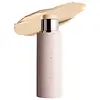What's inside
What's inside
 Key Ingredients
Key Ingredients

 Benefits
Benefits

 Concerns
Concerns

 Ingredients Side-by-side
Ingredients Side-by-side

Caprylic/Capric Triglyceride
MaskingIsononyl Isononanoate
EmollientIsodecyl Neopentanoate
EmollientDicalcium Phosphate
AbrasiveMicrocrystalline Wax
Emulsion StabilisingSqualane
EmollientPolyethylene
AbrasiveVp/Hexadecene Copolymer
Synthetic Wax
AbrasiveDisteardimonium Hectorite
StabilisingHydrogenated Polyisobutene
EmollientSilica
AbrasiveNylon-12
Camellia Oleifera Seed Oil
Skin ConditioningHydrogenated Coconut Oil
EmollientPhytosphingosine
Skin ConditioningButyl Stearate
EmollientIsostearyl Alcohol
EmollientAlcohol
AntimicrobialWater
Skin ConditioningPentaerythrityl Tetra-Di-T-Butyl Hydroxyhydrocinnamate
AntioxidantButylene/Ethylene/Styrene Copolymer
Ethylene/Propylene/Styrene Copolymer
Mica
Cosmetic ColorantDibutyl Lauroyl Glutamide
Skin ConditioningRubus Idaeus Leaf Cell Culture
Skin ConditioningTin Oxide
AbrasiveCaprylic/Capric Triglyceride, Isononyl Isononanoate, Isodecyl Neopentanoate, Dicalcium Phosphate, Microcrystalline Wax, Squalane, Polyethylene, Vp/Hexadecene Copolymer, Synthetic Wax, Disteardimonium Hectorite, Hydrogenated Polyisobutene, Silica, Nylon-12, Camellia Oleifera Seed Oil, Hydrogenated Coconut Oil, Phytosphingosine, Butyl Stearate, Isostearyl Alcohol, Alcohol, Water, Pentaerythrityl Tetra-Di-T-Butyl Hydroxyhydrocinnamate, Butylene/Ethylene/Styrene Copolymer, Ethylene/Propylene/Styrene Copolymer, Mica, Dibutyl Lauroyl Glutamide, Rubus Idaeus Leaf Cell Culture, Tin Oxide
Isoamyl Laurate
EmollientIsodecyl Neopentanoate
EmollientOctyldodecanol
EmollientDicalcium Phosphate
AbrasiveSilica
AbrasiveSynthetic Wax
AbrasiveC10-18 Triglycerides
EmollientHelianthus Annuus Seed Wax
Skin ConditioningKaolin
AbrasiveLimnanthes Alba Seed Oil
Skin ConditioningEuphorbia Cerifera Wax
Synthetic Beeswax
Emulsion StabilisingEthylhexyl Palmitate
EmollientSilica Silylate
EmollientCaprylic/Capric Triglyceride
MaskingPolyhydroxystearic Acid
EmulsifyingTetrahexyldecyl Ascorbate
AntioxidantTocopheryl Acetate
AntioxidantDisteardimonium Hectorite
StabilisingEthyl Vanillin
MaskingTribehenin
EmollientIsostearic Acid
CleansingLecithin
EmollientPentaerythrityl Tetra-Di-T-Butyl Hydroxyhydrocinnamate
AntioxidantPolyglyceryl-3 Polyricinoleate
EmulsifyingRicinus Communis Seed Oil
MaskingSorbitan Isostearate
EmulsifyingHydrolyzed Sodium Hyaluronate
Skin ConditioningSodium Hyaluronate
HumectantLactic Acid
BufferingHydrogenated Castor Oil
EmollientPalmitoyl Tripeptide-1
Skin ConditioningCI 77491
Cosmetic ColorantCI 15850
Cosmetic ColorantCI 42090
Cosmetic ColorantIsoamyl Laurate, Isodecyl Neopentanoate, Octyldodecanol, Dicalcium Phosphate, Silica, Synthetic Wax, C10-18 Triglycerides, Helianthus Annuus Seed Wax, Kaolin, Limnanthes Alba Seed Oil, Euphorbia Cerifera Wax, Synthetic Beeswax, Ethylhexyl Palmitate, Silica Silylate, Caprylic/Capric Triglyceride, Polyhydroxystearic Acid, Tetrahexyldecyl Ascorbate, Tocopheryl Acetate, Disteardimonium Hectorite, Ethyl Vanillin, Tribehenin, Isostearic Acid, Lecithin, Pentaerythrityl Tetra-Di-T-Butyl Hydroxyhydrocinnamate, Polyglyceryl-3 Polyricinoleate, Ricinus Communis Seed Oil, Sorbitan Isostearate, Hydrolyzed Sodium Hyaluronate, Sodium Hyaluronate, Lactic Acid, Hydrogenated Castor Oil, Palmitoyl Tripeptide-1, CI 77491, CI 15850, CI 42090
Ingredients Explained
These ingredients are found in both products.
Ingredients higher up in an ingredient list are typically present in a larger amount.
This ingredient is an emollient, solvent, and texture enhancer. It is considered a skin-softener by helping the skin prevent moisture loss.
It helps thicken a product's formula and makes it easier to spread by dissolving clumping compounds.
Caprylic Triglyceride is made by combining glycerin with coconut oil, forming a clear liquid.
While there is an assumption Caprylic Triglyceride can clog pores due to it being derived from coconut oil, there is no research supporting this.
Learn more about Caprylic/Capric TriglycerideDicalcium Phosphate is an exfoliant.
Disteardimonium Hectorite comes from the clay mineral named hectorite. It is used to add thickness to a product.
It can also help stabilize a product by helping to disperse other ingredients.
Hectorite is a rare, white clay mineral.
Learn more about Disteardimonium HectoriteWe don't have a description for Isodecyl Neopentanoate yet.
Pentaerythrityl Tetra-Di-T-Butyl Hydroxyhydrocinnamate (long name, huh?) is a synthetic antioxidant.
It is used to help stabilize other antioxidants or prevent the color from changing in a product.
As an antioxidant, it helps fight free-radical molecules. Free-radical molecules are capable of damaging our cells and other genetic material. Thus, antioxidants may reduce the signs of aging.
This ingredient is oil-soluble.
Learn more about Pentaerythrityl Tetra-Di-T-Butyl HydroxyhydrocinnamateSilica, also known as silicon dioxide, is a naturally occurring mineral. It is used as a fine, spherical, and porous powder in cosmetics.
Though it has exfoliant properties, the function of silica varies depending on the product.
The unique structure of silica enhances the spreadability and adds smoothness, making it a great texture enhancer.
It is also used as an active carrier, emulsifier, and mattifier due to its ability to absorb excess oil.
In some products, tiny microneedles called spicules are made from silica or hydrolyzed sponge. When you rub them in, they lightly polish away dead skin layers and enhance the penetration of active ingredients.
Learn more about SilicaSynthetic Wax is created from fossil fuels such as natural gas. It is used to enhance texture, adjust pH, and as an occlusive.
It may also be used as an abrasive ingredient to exfoliate the skin.
Synthetic Wax may not be fungal acne safe.
Learn more about Synthetic Wax